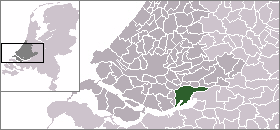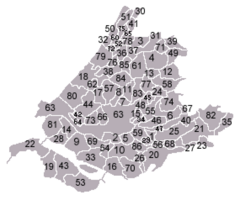Dordrecht
| Dordrecht | |||
|
|||
 |
|||
| Coordinates: | |||
| Country | Netherlands | ||
|---|---|---|---|
| Province | South Holland | ||
| Area (2006) | |||
| - Total | 99.45 km² (38.4 sq mi) | ||
| - Land | 79.53 km² (30.7 sq mi) | ||
| - Water | 19.92 km² (7.7 sq mi) | ||
| Population (1 January, 2007) | |||
| - Total | 118,613 | ||
| - Density | 1,491/km² (3,861.7/sq mi) | ||
| Source: CBS, Statline. | |||
| Time zone | CET (UTC+1) | ||
| - Summer (DST) | CEST (UTC+2) | ||
| Website: www.dordrecht.nl | |||

![]() Dordrecht (population 119,649 in 2004), or in English (and locally colloquially): Dordt, is a city and municipality in the Dutch province of South Holland, the third largest city of the province. The municipality covers the entire Dordrecht Island, bordered by the rivers Oude Maas, Beneden Merwede, Nieuwe Merwede, Hollands Diep, and Dordtsche Kil.
Dordrecht (population 119,649 in 2004), or in English (and locally colloquially): Dordt, is a city and municipality in the Dutch province of South Holland, the third largest city of the province. The municipality covers the entire Dordrecht Island, bordered by the rivers Oude Maas, Beneden Merwede, Nieuwe Merwede, Hollands Diep, and Dordtsche Kil.
The name Dordrecht comes from Thyre, the name of a river, and Middle Dutch drecht "channel", meaning "Thure river crossing". Some documentation speaks of the river actually being called Thuredrith. Inhabitants of Dordrecht are Dordtenaren (singular: Dordtenaar). Dordrecht is informally called Dordt.
Partner cities of Dordrecht are:
- Hastings in England
- Recklinghausen in Germany
- Varna in Bulgaria
- Bamenda in Cameroon
- Dordrecht in South Africa
During Carnaval, Dordrecht is called Ooi- en Ramsgat (Ewe's and Ram's hole), and its inhabitants are Schapenkoppen (Sheepheads). Throughout the year, tourists can buy sheep related souvenirs. This name originates from an old folk story about pillow fight. Import of meat or cattle was taxed in the 17th century. Two men dressed up a sheep they had bought outside the city walls, attempting to disguise it as a man. The sheep was uncovered because it bleated as the three men (two men and one sheep) passed through the city wall gate.
Contents |
History
The city was formed along the Thure river, in the midst of peat swamps. This river was a branch of the river Dubbel and ran approximately near the current Bagijnhof. In 1049 the first reference to Dordrecht was made. Count Dirk IV was murdered that year near "Thuredrech".



Dordrecht was granted city rights by William I, Count of Holland, in 1220, making it the oldest city in Holland.
In 1253 a Latin school was founded in Dordrecht. It still exists today as the Johan de Witt Gymnasium and is the oldest gymnasium in the Netherlands. From 1600 to 1615 Gerhard Johann Vossius was rector at this school.
On 17th April 1421, the Saint Elisabeth's flood drowned large parts of southern Holland, causing Dordrecht to become an island. Over 100,000 people died in the flood.
Because of its strategic location the city developed into an important market city. It traded primarily in wine, wood, and cereals.
In 1572, representatives of all Dutch cities gathered in Dordrecht to declare their independence from Spain and acknowledge William of Orange as the leader of the fledgling Dutch state, marking the beginning of the Eighty Years War.
In 1618/1619, an important church meeting took place, called the Synod of Dordrecht, settling a theological dispute between the orthodox Calvinists and the liberal Arminians that had brought the country on the brink of civil war. The Arminians were defeated, resulting in the formulation of the Dordrecht Confession of Faith.
From 1780 to 1787, Dordrecht was home to the Patriots faction which intended to remove the hereditary Stadtholder position held by the House of Orange-Nassau. The Netherlands was after all a republic de jure. Soon after, more cities followed and William V fled from Holland. But his brother-in-law, King Frederick William II of Prussia, came to the aid of William V and on 18 September 1787, Dordrecht capitulated to Prussian troops. The Patriots were defeated and Willem V was restored in his position as Stadtholder.
In the 18th century, the importance of Dordrecht began to wane, and Rotterdam became the main city in the region. Yet throughout the centuries, Dordrecht held a key position in the defense of Holland. It hosted an army division well into the 20th century. During the mobilization of August 1939, infantry and artillery were sent to Dordrecht to defend the island.
At the end of the Second World War, during the winter of 1944-45, Dordrecht and its surroundings were in the middle between the opposing armies. The border between occupied and liberated regions ran along the Hollands Diep.
In 1970, the municipality Dubbeldam (then ca. 10,000 inhabitants) and the southern part of the municipality of Sliedrecht were incorporated into Dordrecht, making Dordrecht Island one municipality.
Economy
The current economy of Dordrecht is based on ship building, wood industry, and steel industry. The city has the sixth largest sea port in the Netherlands. One of the largest employers on Dordrecht Island is DuPont de Nemours (Nederland) B.V. It has 9 factories here with a workforce of 900 people.
Together with Zwijndrecht, Papendrecht, and Sliedrecht (the "Drecht Cities"), Dordrecht is planning a new ambitious vision to revitalize the region's economy, moving from industry to more business services.
In development are the "Learning" and "Health" Business Parks. The Learning Park is intended to have 60,000 m² of space for educational institutions. In the Health Park, a wide range of health services will be located, with the Dordwijk Campus of the Albert Schweitzer Hospital as focal point. Other services include a blood bank, pharmacy, and mental health clinic.
Near the Health Park a new Sport Park will be built. A new large sport centre, the equivalent size of 3 soccer fields, is planned complete with gyms, skating rink, and a pool. Next to this Sport Park, a huge outdoor event terrain will be established.
Places of interest

- river quay and Groothoofds Gate
- Onze lieve vrouwe Kerk (Our dear lady's Church) or Grote Kerk (Big Church) with uncompleted leaning tower
- canals
- merchant houses
Public transport
Dordrecht is well connected to the Dutch railroad system, and has several international connections. The train system hosts:
Four trainlines
- South-West direction Roosendaal-and further (including international to Belgium/France)
- South-East direction Breda, Eindhoven
- North-West direction Rotterdam, The Hague, Amsterdam
- East direction Gorinchem, Geldermalsen
The four operating trainlines serve three railway stations within the city boundaries (Dordrecht, Dordrecht Zuid, Dordrecht Stadspolders).
Main connections
- Frequent international trains to Antwerp and Brussels, Belgium
- Frequent services within the Netherlands:
- Intercity line to Rotterdam, The Hague, Leiden, Schiphol airport and Amsterdam (north-west)
- Intercity line to Roosendaal and on to Vlissingen (south west)
- Intercity line to Breda, Tilburg, Eindhoven , Helmond and Venlo (south east)
- Several semi-fast services and local trains originate or call at Dordrecht; semi-fast services Amsterdam-Breda.
- Detailed information available from the site of the Nederlandse Spoorwegen (Dutch Railways) [1]
- Arriva, the city bus company of Dordrecht, also serving Werkendam, and also operating the Kop van 't Land ferry on the way.
- Fast Ferry:
- Rotterdam Willemskade - Krimpen aan den IJssel Stormpolder - Ridderkerk De Schans - Alblasserdam Kade - Dordrecht Merwekade.
- Waterbus:
- Dordrecht Hooikade - Zwijndrecht Veerplein - Dordrecht Merwekade - Papendrecht Veerdam - Papendrecht Oosteind - Hollandse Biesbosch - Sliedrecht Middeldiep
Famous people from Dordrecht
- See also People from Dordrecht
- Beatrix the Rich (b. 1420/21?) - an orphan found after the St. Elizabeth's flood whose education was paid for by the city and who became ancestor of many people of Dordrecht.
- Simon "the Danser" Simonszoon (1577-1611) - privateer and pirate
- Gerhard Johann Vossius (1577-1649) - scholar and theologian
- Jacob Cats (1577-1660) - stipendiary magistrate of Dordrecht and Grand Pensionary of Holland
- Matthijs Balen (1611-1691) - writer, famous for Beschryving der Stad Dordrecht ("Description of City Dordrecht") from 1676
- Aelbert Cuyp (1620-1691) - painter, famous for his landscapes
- Cornelis de Witt (1623-1672) - statesman and brother of Johan de Witt
- Johan de Witt (1625-1672) - Grand Pensionary and brother of Cornelis de Witt
- Samuel Dirksz van Hoogstraten (1627-1678) - painter, poet, and composer
- Arnold Houbraken (1660-1719) - painter and writer
- François Valentijn (1666-1727) - dominie and writer, famous for Oud en Nieuw Oost-Indiën ("Old and New East-India"), a book about the history of the Dutch East India Company and the countries of the Far East
- Aart Schouman (1710-1792) - painter and engraver
- Johannes Immerzeel Jr. (1776-1841) - writer and poet
- Jan Schouten (1786-1852) - master ship builder, freemason, and poet
- Ary Scheffer (1795-1858) - painter
- Simon van Gijn (1836-1922) - banker and collector, whose home is now a museum in Dordrecht
- Cornélie van Zanten (1855-1946) - opera singer, author, and teacher
- Karel Lotsy (1893-1959) - sport leader, especially of the Netherlands national football team
- Marinus Vertregt (1897-1973) - astronomer
- Peter Hurkos (1911-1988) - popular entertainer known for performing psychic feats
- Kees Buddingh' (1918-1985) - poet and writer
- Jan Eijkelboom (1926-2008) - journalist, poet, and writer
- Willy Batenburg (1926-2000) - folk singer
- Ad Scheepbouwer (1944) - chairman of the board of KPN
Honorary citizens of Dordrecht
- Simon Marinus Hugo van Gijn (1848-1937), since 1926 - member of Second Chamber of Parliament
- Dr. Theodoor Stoop
- Top Naeff (1878-1953) - writer
- Cees Buddingh', since 1978
- Jan Eijkelboom, since 2001
Image gallery
External links
- http://dordrechtinbeeld.fotopic.net/
- http://www.dordrecht.nl/ (official web site)
- http://www.dordt.nl/
- http://www.fastferry.nl/
- http://www.waterbus.nl/ - map
- http://www.geerts.com/dordrecht/dordrecht-history.htm
- http://trial.blogtronix.net/Blackwolf/
|
|||||||


